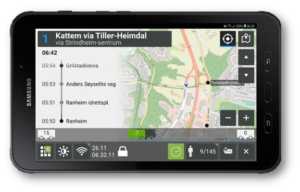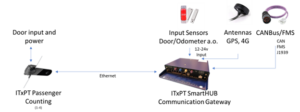4 Reasons why you should consider Passenger Counting:
- Understand passenger flow with vastly improved precision
- Live Capacity Management now and after COVID-19
- Optimise fleets
- Integration with mobile apps, which is crucial for getting passengers back on board and gaining their trust both during and post COVID-19.
1. Passenger flow
The FARA solution allows you to easily identify your vehicles and know exactly how they are being utilised. This goes beyond acquiring data on where people board and alight and extends to:
- Highly reliable object recognition (adults, children and bikes)
- Detection of ‘did not board’, meaning no double registrations
- High level precision of automated passenger counting
- Fulfilling the VDV 457-2 accuracy requirements*
2. Capacity management

- Track passenger load (empty, half full, near full, full)
- Maximum number of passengers defined per vehicle type and operator’s safety protocols.
- Highly relevant during COVID-19 with reduced capacity and beyond
- Alerts based on exceeding maximum passengers
Passenger and driver safety
Due to the COVID-crisis it has become a necessity to meet regulations and protect the health and well-being of travelers and drivers by monitoring the number of passenger’s aboard public transport. Tracking the capacity in real-time, takes the pressure off the drivers and enables them to manage the capacity of the bus with confidence. Operators can set the maximum capacity per vehicle and the passenger count data is shared with both the bus driver and operators via the fleet management tool WebATC. The WebATC also allows it to extract data into different reports, ready for analysis.
Passenger counting vehicle example 1 to 4 doors.
Our colleagues in the UK have implemented passenger counting features with numerous bus operators, and we thought it was worth sharing feedback received directly from an operator on how UK drivers are responding to these enhancements:
“Within hours of launching the new Ticketer Passenger Counting feature, we received lots of great feedback from our drivers that it’s working really well, giving them confidence that they can manage their bus and service safely, and easily. It’s a ‘Big Thumbs Up’ from all our drivers.” Graham Pether, Project Manager Go-Ahead Group PLC.
3. Optimise fleets
By using an accurate passenger count system, operational efficiency will be possible as the precise statistics can be used to plan accordingly.
Long term planning → Optimize your fleet for the current passenger flow, track impact and revenue sharing.
When passenger counting is implemented, everything becomes trackable. Using the data acquired, operators can plan routes and services with ease, knowing that they will be able to manage capacity requirements. Furthermore, operators will be able to gain insights on the effects of campaigns and advertisements.
Short term plan → Track impact
Two examples:
- Tracking journeys with the highest passenger load. Here the follow-up measurement could be to add more departures.
- Events: Ad-hoc measurements. Too few buses to match the passenger flow -> add buses
Passenger journey data for revenue sharing (multi-operator)
For travels between operator’s, ticket revenue sharing is key and should be done based on accurate data. By being able to track all passenger journeys as our feature enables, it will be possible to do so.
Why is Passenger Counting better than relying solely on your Ticketing system?
Ticketing systems on their own, cannot deliver the same accuracy as passenger counting. Ticketing data is obtained on tickets sold per line and it does not track the actual onboarding and alighting data.
Tor Asbjørn Eggen, Product Owner: ‘’FARA’s passenger counting solution bring insight to our customers about the passenger flow and travel patterns, as we are combining the journey data with the counting data, utilising this in the best manner in real time operation. ‘’
4. FARA’s Passenger counting is quick, efficient, and effective
Our system enables quick insights on the number of passengers per vehicle, supporting operators to care for their drivers and passenger’s safety. Passenger counting data is very detailed, providing overview on passenger travel behaviour per stop, allowing improvements in bus operations.

